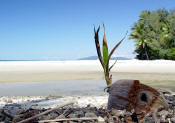

Welcome to CookCoconuts.com.
Here You Can Learn All About Coconuts!
How to Know if a Coconut is Fresh?
All coconuts are not the same. The coconut is basically a seed from a coconut palm tree. Originally thought to be native to the Greater Pacific Asia Indo Area of the greater tropics, coconuts are grown everywhere around the world. The coconut is mostly a tuff fibrous outer sell called the husk. It is a bright green when young, and a fibrous brown when mature with a texture like a burlap.

Inside a Coconut
All this surrounds a brown softball-sized inner shell that surrounds the coconut meat, milk, and coconut water. Enclosed in the shell is bright white meat (the actual eatable coconut) that can be used for eating, cooking, and processing. Getting to the actual coconut meat can be very difficult. (see our instruction on how to open a coconut)
Most all types of coconuts are available for harvesting year-round, though the coconut palm trees that they grow on will only fruit the green coconut in hot weather. The coconut can be removed from the tree as soon as it is about a big as a bowling ball. It may be green or brown, it really doesn’t matter because it will be good for eating either way. But once the coconut turns brown, it is only good for eating for about another 1 to 2 weeks.
To ultimately determine if a coconut is good to eat, remove the inner shell from the outer hush. (see our page on how to open a coconut) Shake the inner coconut shell close to your ear and if you can hear liquid shaking in the shell than it may be good for eating. But, the best way to determine if the meat is still fresh and eatable, you must open up the coconut for inspection. if it smells good and looks go than eat away.
How To Open a Coconut: Use & Preparation:
- Drain coconut through a fine-meshed sieve to reserve liquid.
- Removing the coconut meat can be done in several ways.
- Usually, the easiest is to tap the “nut” with a hammer to loosen meat, then tap hard enough to crack the nut open.
- Remove meat in pieces, using a regular table knife.
- Trim off the brown layer with a sharp knife or vegetable peeler.
- Rinse, then grate, chop or puree and use as desired.
- With greener coconuts in may be helpful to place the whole coconut in a 350 degrees F. oven for 15-20 minutes, then proceed with the above steps to remove the liquid and coconut meat.
- Yield: 1/2 lb coconut yields approximately 3 C grated.
“IMPROVE YOUR HEALTH” Buy A Fresh Young Coconut Today!
A Little Coconut History
Here in Southern Florida, coconut’s fist came about in the 1880s when a shipwrecked a couple of miles away from Palm Beach.

The coconut palm’s that the ship was transporting broke free and the warm waters of the Gulf Stream brought the coconuts to the beaches of South Florida. And as a natural phenomenon, the coconuts took root and sprouted on the beach. This is how the explorers of Southern Florida first saw the beaches and in one case named the beach after what they saw, a “Palm Beach”. The rest was history! All thanks to a passing shipwreck and a boat of passing coconut palms.
All About Coconuts Printable Document
Coconut Nutritional Qualities.
Since the 1950s, coconut oil has been labeled as unhealthy. The media reported how tropical coconut oils were filled with fatty artery-clogging fats. What was not reported was that the coconut oil used was hydrogenated and not the virgin oil used for our foods today. We now know that hydrogenation (which is the artificially adding a hydrogen molecule to oils ) not oil. Hydrogenated corn, canola, and soy oils are filled with dangerous trans-fats and processed with toxic solvents that are commonly added to packaged foods. Why is it that baby formula includes coconut as an ingredient? Because coconut oil is one of the most healthy foods on this planet. Coconut oil is (cholesterol) and trans fat-free and contains 1% omega (6) and is very rich in medium-chain (good fats) that are recommended by doctors.

Coconut Nutrition Shell
One of the (good fats) that comprises 50% of coconut oil, is called lauric acid. Lauric acid is a medium-chain fatty acid found in “mother’s milk” that supports healthy metabolism and is now being studied for its antiviral, antifungal, & antibacterial properties. Researchers say that lauric acid will soon become as well known as Omega-3. The Monsanto company developed a GMO canola oil that attempts to mimic coconut oil’s high (%) of lauric acid. Coconut oil is making a comeback as we learn more about the downsides of consuming too many Omega-6 vegetable oils. Experts suggest that (3) tablespoons of extra virgin coconut oil a day is good.
Hydrogenated Trans Fat or Healing Coconut Oil
The FDA will be required to label “trans fats” in 2006. Additionally, the entire fat industry is undergoing a federal review of its guidelines. That means that Nutiva is positioned to offer the “good fats” in its coconut oil products, which can play an important role in personal health. no longer will you hear: “zero fat equals good,” “tropical fats equal bad,” and “vegetable oils are beneficial”. Did you know that Pacific Islanders who eat coconuts every day have a low incidence of heart disease and are seldom overweight? When an American diet which includes vegetable oils replaces a Pacific Islander diet, all the fat-related diseases which are common in America start to appear.
Quick Ship Fresh Coconut Delivery!!!
(Buy Coconuts From Our Cooky Coconut Store)
To remove coconut meat from the shell, pierce at least two of the “eyes” with an ice pick.
NEW! : Vitamin Filled Coconut Water (Click Here)
